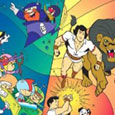Filmation (1977), BCI (August 22, 2006), 2 discs, 341 mins plus supplements, 1.33:1 original full frame ratio, Dolby Digital 2.0 Mono, Not Rated, Retail: $19.98
Storyboard:
Three youths are given superpowers by an extraterrestrial race, then are returned to Earth to fight for justice. Plus, a group of mythological heroes does likewise.
The Sweatbox Review:
BCI has already done a fantastic job bringing to market DVD collections of several classic shows in the Filmation library. When Space Sentinels & Freedom Force was announced, though, I was surprised. Compared to He-Man or Flash Gordon, these other shows were pretty obscure. In fact, as big a cartoon watcher as I was in the 1970s, I had no recollection of Space Sentinels aside from what I had read about in later years. What I knew, though, was enough to convince me to check out this set. The added bonus of carrying a segment of Tarzan and the Super 7 sealed the deal.
Space Sentinels was created by the Filmation team in 1977 for NBC’s Saturday morning lineup. The series was initially pitched, and ran, as Young Sentinels, but the word “Space” replaced “Young” a few months into the show’s run at the insistence of the network, in a bid to garner stronger ratings. Assumedly, the success of 1977’s Star Wars had a little to do with that. The name change was a bit of an odd choice, as few episodes actually take place in space.

The “origin” of the characters was never dealt with to a large degree in any of the episodes themselves, but the opening for the show describes the premise. Long ago, three youths from various parts of the world were abducted by an alien species, taken back to the aliens’ home world, and modified to be given superpowers and immortality. They were then returned to Earth, based in a rocket ship inside a dormant volcano. From that location, they would be notified of various threats around the world and instructed by a computer hologram named Sentinel One.
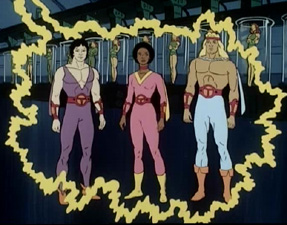
The three heroes were named for mythological heroes of Earth’s past, and in the context of the show were said to have actually inspired those legends. Hercules was very strong, of course, while Mercury was extremely fast, and female Astraea was a shape-shifter who could take the forms of animals. Visually, the characters were designed to be racially diverse— Hercules a blonde Caucasian, Mercury Asian, and Astraea being black. Filmation producer Lou Scheimer was insistent that the characters not simply be a white-skinned group, as the Filmation audience was not exclusively Caucasian. Filmation went a step further and had Astraea be the team leader. The writing of the show rarely alluded to the ethnicities of the characters, with one example being Mercury saying that even he could not make sense of a situation that was similar to a Chinese puzzle (“Don’t look at me, I’m as lost as the rest of you”).
In fact, the characters were really quite generic once you got past the visuals. They had personalities, but none of them received any true characterization. The three heroes joked around and spent the whole show communicating, but no one ever grew emotionally. This was old-time Saturday morning TV, assumedly watched by only youngsters who assumedly had little interest in character development.

The plots of the thirteen episodes, though, had an interesting variety to them. Space Giants featured the group going against giant robots led by a bald green woman, The Time Traveler saw the team chasing said villain into the past, and The Return of Anubis mixed Egyptian mythology into the show. The Prime Sentinel tried to expand the show’s mythology a bit, as they actually go out into space to save the head Sentinel and meet other young champions. They go under the sea after Commander Nemo and back into space to solve the mystery of The Jupiter Spore. They deal with magic and fantasy in The Wizard of Od and go to the Earth’s core in Voyage to the Inner World. The rest of the episode titles include Morpheus: The Sinister Sentinel, The Sorceress, Loki, Fauna, and The World Ship.
The funny thing is, I can barely remember watching any of these right now, despite just having gone through the set. Space Sentinels is really an attractive show, well designed and mounted, and the stories are fun enough, but nothing is too memorable. Maybe I did actually see the show when I was younger and simply forgot it all. It simply fails to make much of an impression, despite its production quality. The stories are plenty wild, reminding me somewhat of the last two seasons of the original Spider-Man cartoon, but Space Sentinels has little personality. The characters are appealing but bland, and there is no continuity between episodes. The existence of the comedy relief given by a supposedly cute little robot on their ship, named M.O., annoys more than entertains— even if he has more personality than the humans.

I do have to say that the drawing seen on the show impressed me. The animation is typically limited, but the artists did as great job making the realistic models look good in every shot. I am less a fan of the costume designs, which make the fellas look less than masculine, but they work better and seem less sissy if you think of them as circus costumes rather than superhero outfits. Adding to the plus side, however, is that the backgrounds are nicely detailed and overall the show looks very professional— particularly when compared to some of the outsourced stuff that Hanna-Barbera was putting out at the time. All the work, aside from film processing, was done at Filmation’s building, a true all-in-one operation. Scheimer was always very proud that he kept the work in the States, even though it was probably a factor that helped to lead to the studio’s closure in the 1980s.
If only the animation and staging were as strong as the drawing! At times it seems that everything is done to be as un-dramatic as possible. Characters move from right to left or left to right. Camera angles are usually squared off. It all looks good, but the action never takes it up that extra notch to make the show exciting, which led to my mind wandering when I should have been riveted by the action. The exceptions are a few stock animation sequences, such as when the characters fly down then up in front of the camera.

Moving on to Freedom Force (no relation to the video game), we see similar animation but the character designs are more appealing. This is another team of mythological heroes, including Hercules again (whose costume seems to work better on this show since it doesn’t appear to be set in the present). There is no explanation as to how Freedom Force may tie into the continuity of Space Sentinels, but I don’t think the writers were really too concerned about that. Nevertheless, the existence of Hercules on both shows would seem to be the reason they were paired for this DVD release. Freedom Force was a segment on 1978’s fondly remembered Tarzan and the Super 7. These segments continued to appear when the show became Batman and the Super 7, which lasted until 1981.
Joining Hercules were Isis (the weather goddess who had been a live action star for Filmation since 1975), Sinbad (along wit his sidekick Lamprey), Merlin (looking young, unlike the usual portrayal of an old man), and Super Samurai (a type of Captain Marvel character, as this was a young Japanese boy who shouted “Super Samurai” to transform into a giant armored hero). This group operated from a pyramid in the Valley Of Time. The exact time and place were left uncommented on, though it seemed to take place in a mythological past. The Freedom Force acted to preserve peace, responding to whatever threats came up. Only five ten-minute episodes were ever made, including The Dragon Riders, The Scarlet Samurai, The Plant Soldiers, Morgan’s Revenge, and The Robot.
Like Space Sentinels, the stories on Freedom Force are nicely drawn but underwritten. At only about ten minutes each, though, there is little time to get bored.

Is This Thing Loaded?
BCI doesn’t seem to distinguish much between high-end and low-end sales expectations when it comes to creating content for their animation sets. Even though these two shows are relatively obscure, they serve up a nice selection of extras, courtesy of DVD content producer Andy Mangels.
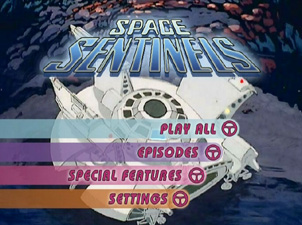
The first side of Disc 3 carries bonus material for Space Sentinels. An Image Gallery carries over 50 shots of model sheets and presentation artwork. Interviews that may be played separately or all at once (22:01) allow us to hear from Producer Lou Scheimer, writer Michael Reaves, designer Robert Kline, and writer David Wise, who all share memories of what made Space Sentinels special. Young Sentinels Original Presentation (2:37) is the only true look we get at the tam’s origin, and for that reason alone is worth watching, plus these tings are always neat to see anyway. Live Action Auditions (4:54) is just as it suggests— a look at three young performers trying out for a planned live action take on the show. It’s really quite cool that this could be found and included on the set.

The second side of Disc 2 holds the balance of extras. The Magic Of Filmation (32:44) is a documentary of the history of the studio, and I have to admit that this was my main reason for buying this set. It is wonderful to hear Lou Scheimer describe the origins of the studio, and he is joined in the documentary by about a dozen others, including familiar writers Paul Dini and Joe Straczynski, and Scheimer’s own daughter and wife. There is not much information on individual shows, but for its running length the documentary does a nice job as an overall retrospective of the studio. It sounds like it was a special place, as many describe it as a “family” type of company and say that working there was a career highlight.
More Interviews follow (13:03 total), this time with Scheimer, writer Buzz Dixon, and layout artist Darrel McNeil commenting on Freedom Force. The Image Gallery for the show carries 16 shots of model sheets.
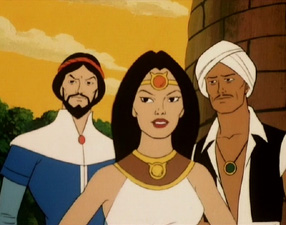
DVD-ROM: Plop either side of disc 2 into your PC or Mac, and you can read the scripts for ALL of the episodes on this set! Pretty cool, if you’re a script guy.
Case Study:
BCI continues to make collectors feel valued with how they package their releases. This set comes in a thicker keepcase that holds a tray for one of the discs. The case fits into the side of a slip-sleeve with a nearly identical cover, the only exception being switching out an image of Isis for Hercules on the spine. The keepcase holds a nicely produced episode guide with liner notes. There is also a Funimation catalog.
The discs are DVD-10s, single-layered, and double-sided. So, there is no disc art, but the hub labels are easy to read at least. Space Sentinels appears on the first three sides, while Freedom Force gets the final side. The extras for each show are split up appropriately as well.
Ink And Paint:
For shows from almost thirty years ago, they actually look quite god on this release. The standard physical artifacts are there— dust that was part of the cartoon’s original photography— but otherwise the prints used are surprisingly good. This was a pleasant surprise after my disappointment with the Flash Gordon source material. The transfers were also done well, exhibiting practically no shimmering effects or halos. Even the expected visual softness for shows of this vintage isn’t really an issue. Very nice.

Scratch Tracks:
Generally the audio is quite good, considering the show’s vintage and the mono soundtrack. Seventies shows are not known for their rocking aural effects, and these series are no exception. Like the shows themselves, everything is clearly portrayed in the sound department, but the audio does little else to impress. One problem that is present in every episode of Space Sentinels is that one can barely hear the voiceover during the show’s opening, as the music and effects are cranked too high. This makes it difficult to grasp what the premise of the show is, and one has to go mainly by the visuals.

Spanish audio tracks are available on only the Space Sentinels shows, and there are no subtitles available.
Final Cut:
Watching these cartoons, I couldn’t help thinking, “Now THIS is what Saturday morning looked like when I was a kid!” There is good and bad in that statement. I loved seeing the clear, classic design elements, including well-drawn “realistic” characters. The stories are loopy fun in premise, but fall short of being too awesome because of the restrained manner in which they are presented. Everything had to be done “safe” back then, with networks and community groups demanding that cartoons be kept as non-threatening and generic as possible. At least Lou Scheimer and Filmation insisted on injecting diversity and social values into their shows, and kept the production values high enough to end up with handsome programs even if the animation had to be limited and recyclable.
As much as I identify these shows as being typical for that period from my childhood, they are unfortunately not particularly memorable. The value of this set likely lies in nostalgia or as an object of scholastic inspection. To coin a metaphor, the shows are good fast food in a gourmet sauce. If your tastes lie in that direction, you may enjoy seeing these typical examples of Filmation product from the 1970s. Certainly, BCI and content producer Andy Mangels have done a superb job at making these shows as marketable as possible for collectors, with quality bonus features, good transfers, and classy packaging.
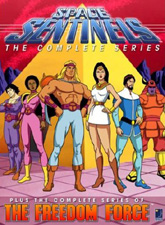 | ||
 |






